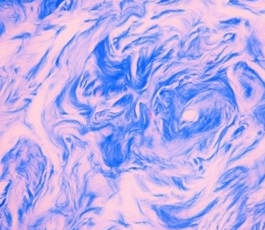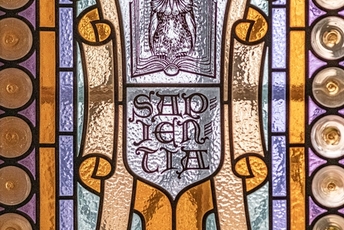The exhibition has been prepared by the Wytwórnia Filmów Oświatowych w Łodzi (Educational Film Studio in Lodz) in cooperation with the University of Lodz Library as part of the 20th edition of the Włodzimierz Puchalski International Nature Film Festival. The University of Lodz library is a partner of the festival.
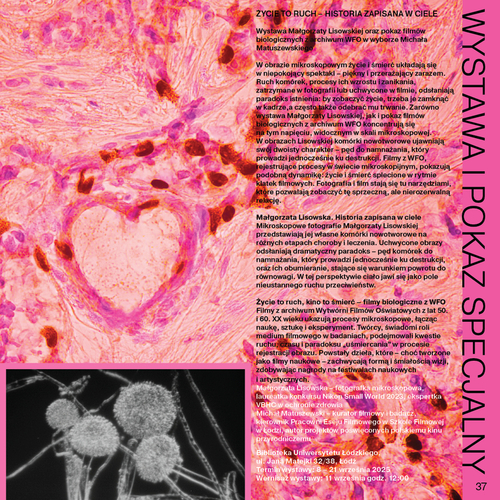
Małgorzata Lisowska. Life is Movement – History Written in the Body
In the microscopic image, life and death form a disturbing spectacle –beautiful and terrifying at the same time. The movement of cells, the processes of their growth and decay, captured in a photograph or on film, reveal the paradox of existence: to see life, one must frame it, and often also deprive it of its existence. Both Małgorzata Lisowska's exhibition and the screening of biological films from the Educational Film Studio in Lodz archive focus on this tension, visible on a microscopic scale. In Lisowska's images, cancer cells reveal their dual nature – a drive to multiply that simultaneously leads to destruction. The films, capturing processes in the microscopic world, demonstrate a similar dynamic: life and death intertwined in the rhythm of film frames. Photography and film become tools that allow us to see this contradictory yet inextricable relationship.
The process of neoplasia reveals a fundamental paradox – the intertwining of life and death. The neoplasticity of cells expresses their desire for life and multiplication. However, it is their chaotic growth that ultimately leads to destruction. On the other hand, the death of cancer cells opens the way to life. Their elimination by the body's defence mechanisms or therapeutic interventions restores balance and allows life to continue. Thus, in the process of neoplasia, death and life are mutually dependent, creating a constant movement of opposites taking place in the body.
Małgorzata Lisowska
Małgorzata Lisowska is a microscopic photographer. She is the winner of the prestigious Nikon Small World 2023 competition with a photo of her own cancer cells – Poland's first return to the podium after 31 years. She is the author of the exhibition "History Written in the Body in Three Acts," presented at venues including the National Health Fund.
She has been an ambassador for the Dutch organisation Value Based Healthcare Center Europe since 2020. She cooperates with EIT Health as a mentor for medical startups and educational programmes in the VBHC area. She is a lecturer in the MBA programme in healthcare and an expert at the Institute of Healthcare Management at Lazarski University. She is a former oncology patient (breast cancer, 2023).
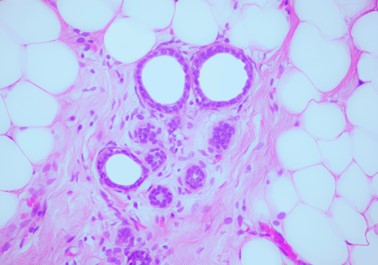
Life is movement, cinema is death – biological films from the Educational Film Studio
The Educational Film Studio in Lodz produced a series of films in the 1950s and 1960s in which the logic of science, art and cinema is inextricably intertwined. The filmmakers working at the Studio were acutely aware of the role of the film medium in research and its application to understanding the world. In these films, key issues of cinematic theory – the question of motion and time, the possibility of depicting life and the paradox of constant death – both in scientific specimens and in the film frame – are at full speed. They can therefore be unsettling. We witness a beautiful yet terrifying spectacle of cinematic death and life. These films, although created as biological, microscopic, scientific and popular science films, can also be successfully considered experimental or avant-garde. Their creators – like avant-garde filmmakers – searched for new means and techniques to present things on screen that had never been shown before. It should be mentioned that these films received awards at both scientific and experimental festivals, and Karol Marczak – the doyen of Polish biological cinema – lived in Paris in the 1920s, where he was an assistant to Władysław Starewicz, a pioneer of animation.
Michał Matuszewski
Michał Matuszewski is a film curator, festival programmer, researcher, author and a film essayist. He was the cinema curator at the Ujazdowski Castle Centre for Contemporary Art until 2022. Subsequently, he was the Head of the Film Essay Workshop at vnLab at the Lodz Film School, and a co-curator of the Polish Experimental Film Competition and the International Competition at the Short Waves festival. He is currently working on a doctoral dissertation on Polish nature films at the University of Warsaw.
He has been a jury member at international festivals, including Cannes, Berlin, Venice and Oberhausen. Michał Matuszewski is interested in new media and VR, particularly their institutional aspects and the non-human perspective in the cinema. He is a holder of a grant from the Culture & Animals Foundation. He has been working on a visual research project devoted to animals in film. His latest essay project, "Re-membering Topsy," has been presented at the National Museum in Warsaw.
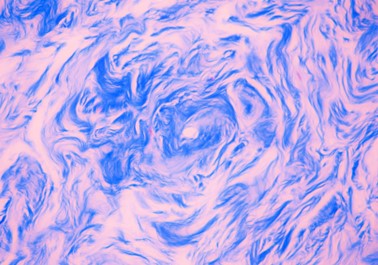
The exhibition can be viewed from 8 to 21 September 2025, during the opening hours of the University of Lodz Library.



